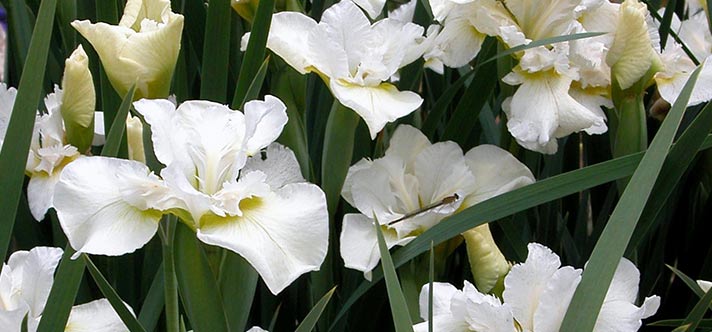Your questions (FAQ)
The first and second flowerings of my irises were correct, but this year I have only blues & whites - what's happened?
Certain varieties are more prolific than others or have a more robust vegetation, thus they end up smothering the others. It is therefore important in a border of mixed varieties to keep an eye on the growth of the stronger ones. It is not possible for an iris variety to degenerate or change colour.
My irises are invaded by weeds, are there any specific weedkillers I can use?
Yes, there are several weedkillers tolerated by irises (notably some anti-germination ones). However none is really officially recognised as such. Thus we can advise various products but in the case of their not working we cannot be held responsable.
How often should one divide iris clumps?
On average every 3 to 5 years. As soon as the flowers start to diminish in size or number, this is the sign that it is time to divide the clumps. This operation takes place in summer and you should only keep the rhizomes found furthest from the centre of the crown (as these are the healthiest). When you can, it is better to replant these new rhizomes in a different place. Click on' How to Grow Iris' (left) for help on how to divide irises.
My irises flowered well the first year, since then I've had fewer and fewer flowers.
A lack of flowers can be due to various reasons:
- The rhizomes are too crowded, it is time to divide them.
- You thought you were doing your iris a favour giving them a boost with a nitrogen-rich fertiliser : the problem is that nitrogen encourages foliage growth to the detriment of the flowering.
- The iris bed is not getting enough sun: the best solution is to move the irises, preferably in the right season (summer).
- The ground is too heavy, too sticky and is preventing good rhizome development : you must lighten it with compost but also horticultural lime because composts tend to acidify the soil.
- The soil is too acid for bearded iris (the ideal pH is 7 although iris are fairly tolerant in this regard) : 100g to 200g of lime per m² increases the pH level and encourages flowering (recommended in acid soil regions.)
How should I deal with the spots that appear on the leaves in spring?
This is the main problem with iris : they are often attacked by leaf spot in spring. Preventative treatment with fungicides contaning Manebe, Mancozebe, Folpel or even copper can be successful, provided it is done quite early in the season (around 15 March) and repeated twice more at monthy intervals and you alternate the product each time. The richer the soil is in organic material the better the plant can defend itself against this disease. However unsightly leaf spot appears, it never causes the death of the iris.
You haven't found the answer to your question?
Send us an email at info@iris-cayeux.com and we will reply as soon as possible, or call us on 0800 096 4811 (Freephone from the UK) or 0033 238 670 508 (non-UK English speakers) .

